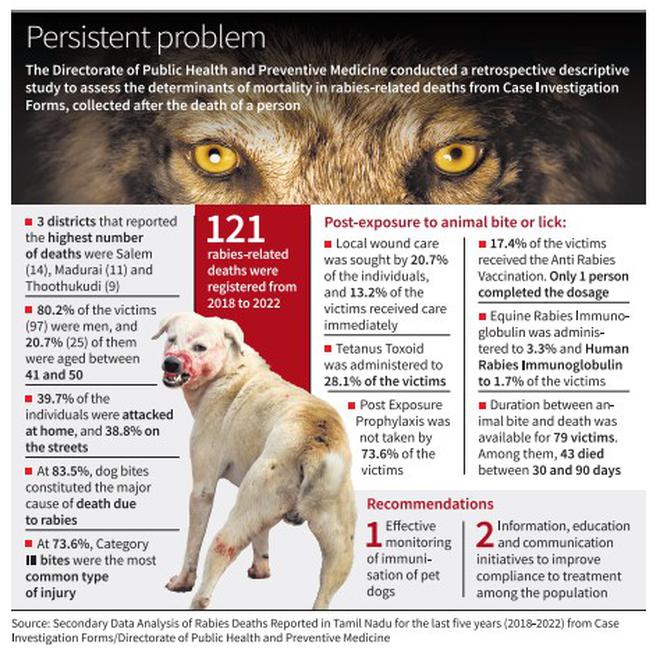More than half of the persons who died of rabies from 2018 to 2022 in Tamil Nadu did not get vaccinated against rabies. In fact, an analysis of these deaths showed that pet dogs were the major source of infection.
In a study - Secondary Data Analysis of Rabies Deaths Reported in Tamil Nadu for the last five years (2018-2022) from Case Investigation Forms (CIF) - published in the State’s public health journal, researchers of the Directorate of Public Health (DPH) and Preventive Medicine took a closer look at 121 rabies related deaths that were registered in the Zoonotic division of the Communicable Disease section of the DPH. Secondary data on the determinants leading to death were obtained from the CIF used in T.N. CIF, the authors said, was a verbal autopsy tool used by trained healthcare workers to collect details from relatives/close acquaintances of the deceased.
The analysis showed that the majority of the victims were men - 97 - of which 25 were aged between 41 and 50 years. About 70% of the victims were from village panchayats, while only 8.5% were from corporation/urban local body areas.
Dog bites were the major cause of rabies death, with 83.5% of 121 victims suffering a dog bite. Category III bites were the most common type of injury as diagnosed in 73.5% (89) of them. Injury-wise, 54.5% of the victims sustained single injury and 38.8% sustained superficial injury with bleeding. Most of them sustained injury in the lower limbs or toes.
Of the 121 victims, Tetanus Toxoid was administered for 34 persons. The analysis showed that 73.6% of the victims did not take Post Exposure Prophylaxis, while 17.4% (21) received Anti Rabies Vaccination (ARV), the course of which was completed by only one victim. Equine Rabies Immunoglobulin was administered to 3.3% and Human Rabies Immunoglobulin to 1.7% of the cases.
A total of 48 (39.7%) of them were attacked at home and 47 (38.8%) on the streets. In 51 cases, it was a pet involved - 39 household pets and 12 neighbours’ pets. A total of 41 stray animals were involved.
Elaborating on the vaccination status of the animals, the authors said 54 of the dogs were not vaccinated against rabies, while the vaccination status was not known in 41 cases. Only 21.5% of the animals were suspected to be a rabies infected animal and only 14.9% of the animals were observed for 14 days to see if they were healthy and alive. A total of 57 of the animals were found to be dead later. None of the dead animal’s brain was sent for laboratory testing for rabies virus.
The authors noted that government hospitals were the preferred site for wound care and treatment, while private institutions were preferred for management of rabies-infected victims. The analysis noted that the majority of the victims in the study presented with difficulty in swallowing and hydrophobia followed by difficulty in breathing.

One of the authors, T.S. Selvavinayagam, Director of Public Health, said, “What we observed is that incomplete vaccination is one of the major reasons for death. People should take animal bites seriously and get vaccinated. We assume that pet animals are safe but it is not so. Even if the pet animal is vaccinated, people should get vaccinated against rabies in case of bites.”
With the Drug Distribution Management System, availability of ARV has been ensured in all Primary Health Centres, he said. Utilisation of immunoglobulin for Category III bites is poor, and healthcare staff need to be trained, he added.







